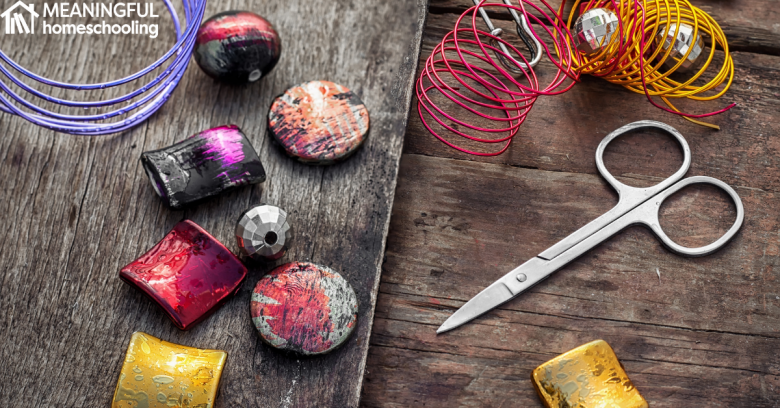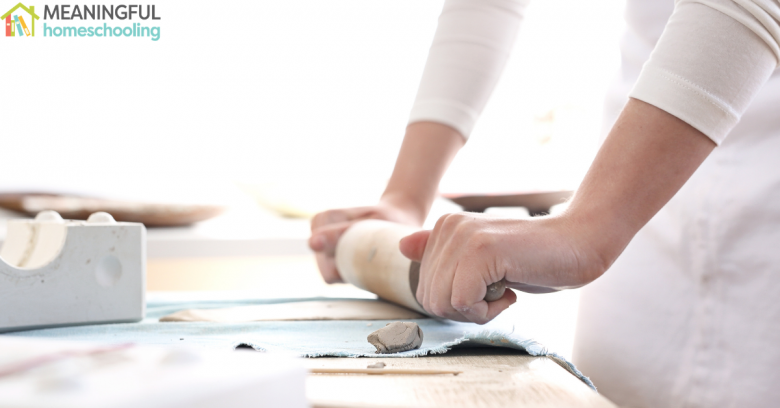What are Handicrafts? And Why You Should Use Them
Handicrafts… a word you’re either familiar with or have never heard of before, especially in the homeschooling world. But if you’ve followed the Charlotte Mason homeschooling method, then having handicrafts and using them is like second nature. If you’re curious about them and how to incorporate them into your child’s home education, keep reading!

What are handicrafts?
Before you think this is just another way to pile yet another homeschool activity on your plate, allow me to explain. Yes, handicrafts fall under the category of artistry or working with ones hands using a variety of tools and supplies, but there are many benefits that accompany. For starters, handicrafts take a child back to the roots of how things were once created. Think scissors, carving implements, or hooks versus tech-rich tools. In addition, other benefits include:
- Hand-eye training. Without much effort, handicrafts provide lots of opportunities for observation. They also train your child’s hand and eye coordination to work in sync, like an ebb and flow. The more practice they get, the more skillful they will become.
- Enhance artistic creativity. Simply put, even the least artistic child will benefit from handicrafts. They help cultivate a child’s sense of and appreciation for art.
- Works muscle memory. Tuning the hand muscles is an important skill for children, especially when they are at the peak of learning to write or writing for extended periods of time. Regardless of the handicraft you select, it will provide a great training ground for manual dexterity.
- Experiment with different materials. The more our society progresses, the less experience our children have with a variety of objects. Handicrafts reintroduces something that was common and native to our ancestors. There’s great joy in sharing that with them.
- Increases productivity. Since most handicrafts require focus and act of producing a finished work, this skill is increased quite naturally.
With these benefits in mind, let’s look at practical ways to add handicrafts in your homeschool.

How to Choose Handicrafts for Your Child
Don’t worry, you won’t need to go spend hundreds of dollars at the nearest Hobby Lobby or Jo-Ann’s craft store. You probably have more handicraft materials laying around your home than you’re aware of. However, to be fair, they may be times when you’ll want to invest in a particular craft or activity.
Choose development-appropriate handicrafts.
Typically you’d want to choose something by the age, but in this case, it’s best to judge by a child’s development level. It’s quite possible for a six year old to out-sew a ten year old, simply because of their developmental levels.
Make sure the project is useful.
If there’s one thing Charlotte Mason stood behind when it came to handicrafts, it’s the fact that children should not be learning aimlessly. Instead, their education and learning experiences should always have a part in a much larger role in their lives. The skills acquired from the handicraft should be an effort to bestow some rooted knowledge that will be exercised later.
Model what should be done.
In other words, teach your child “slowly and carefully what they are to do.” Allow several weeks to learn the skills step by step and ensure they are learning them correctly. It is much easier in the long run to take the time necessary to teach something correctly, versus taking even longer to reverse a skill taught incorrectly.

How to Use Handicrafts in Your Homeschool
Depending on what your child completes, handicrafts can typically be used in the home. Think pot holders, vases, bird houses, boxes, thank you cards, etc. In your choosing, keep this in mind. Handicrafts are also a great source for gift giving and can provide extra motivation to do good work. They are also perfect for donating for charity. Connecting your child with a local organization, a church ministry, or another donation outlet can help them see the fruits of their labor.
Final Thoughts
Handicrafts are a great way to keep your child’s minds busy but being productive and helpful at the same time. There isn’t a lack in craft opportunities and they can be a wonderful means of ministry to others. Do you use handicrafts in your homeschool? Let me know in the comments below!
